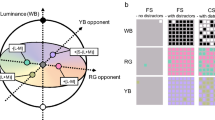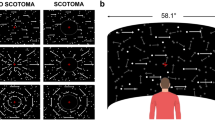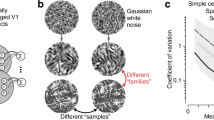Abstract
Objects in peripheral vision are not simply blurred but lack quality of form1. Assuming that the visual system performs a (patchwise) Fourier analysis of the retinal image (for review see ref. 2), it has been suggested that this disadvantage of peripheral vision may be due to the inability to encode properly spatial phase relationships3–5. This is of great interest for neurological research as certain visual pathologies imply alterations of perceived form6,7. Previous attempts at measuring phase sensitivities failed to distinguish between the detection of phase-related changes in contrast and phase coding in the visual system8. We separated these processing strategies by applying the iso-second-order texture paradigm of Julesz5 to the discrimination of compound gratings. Our results, reported here, show that the energy detection properties of both foveal and peripheral vision are comparable, however, independently of scale, peripheral vision ignores the relative position of image components.
This is a preview of subscription content, access via your institution
Access options
Subscribe to this journal
Receive 51 print issues and online access
$199.00 per year
only $3.90 per issue
Buy this article
- Purchase on Springer Link
- Instant access to full article PDF
Prices may be subject to local taxes which are calculated during checkout
Similar content being viewed by others
References
Aubert & Foerster Albrecht v. Graefes Arch. Ophthal. 3 (II), 1–37 (1857).
Braddick, O., Campbell, F. W. & Atkinson, J. in Handbook of Sensory Physiology Vol. 8 (eds Held, R., Leibowitz, H. W. & feuber, H. L.) 3–38 (Springer, Berlin, 1978).
Braddick, O. Documenta ophth. Proc. Ser. 30, 255–262 (1981).
Hilz, R., Rentschler, I. & Brettel, H. Expl Brain Res. 43, 111–114 (1981).
Julesz, B. Nature 290, 91–97 (1981).
Hess, R. Hum. Neurobiol. 1, 17–30 (1982).
Milner, B. & Teuber, H. L. in Analysis of Behavioral Change (ed. Weiskrantz, L.) 268–375 (Harper & Row, New York, 1968).
Badcock, D. R. Vision Res. 24, 613–623 (1984).
Oppenheim, A. V. & Lim, J. S. Proc. IEEE 69, 529–541 (1981).
Burr, D., Vision Res. 20, 391–396 (1980).
Julesz, B. Scient. Am. 232(4), 34–43 (1975).
Green, D. M. & Swets, J. A. Signal Detection Theory and Psychophysics, 40–43 (Krieger, Huntington, 1974).
Rovamo, J. & Virsu, V. Expl Brain Res. 37, 495–510 (1979).
Atkinson, J. & Campbell, F. W. Vision Res. 14, 159–162 (1974).
Hauske, G., Lupp, U. & Wolf, W. Biol. Cybernet. 22, 181–188 (1976).
Pollen, D. A. & Ronner, S. F. Science 212, 1409–1411 (1981).
Green, D. M. & Swets, J. A. Signal Detection Theory and Psychophysics, 211–218 (Krieger, Huntington, 1974).
Rentschler, I., Hilz, R. & Grimm, W. Nature 253, 444–445 (1975).
Bergen, J. R. & Julesz, B. Nature 303, 696–698 (1983).
Dorfman, D. D. & Alf, E. Jr, J. math. Psychol. 6, 487–496 (1969).
Author information
Authors and Affiliations
Rights and permissions
About this article
Cite this article
Rentschler, I., Treutwein, B. Loss of spatial phase relationships in extrafoveal vision. Nature 313, 308–310 (1985). https://doi.org/10.1038/313308a0
Received:
Accepted:
Issue Date:
DOI: https://doi.org/10.1038/313308a0
This article is cited by
-
Improving target detection with nonlinear magnification in visual inspection
The International Journal of Advanced Manufacturing Technology (2006)
-
Detection of narrow bars when presented in the right and left visual hemifields
Neuroscience and Behavioral Physiology (2005)
-
Detection of narrow bars when presented in the right and left visual hemifields
Neuroscience and Behavioral Physiology (2005)
-
Detection of narrow bars when presented in the right and left visual hemifields
Neuroscience and Behavioral Physiology (2005)
Comments
By submitting a comment you agree to abide by our Terms and Community Guidelines. If you find something abusive or that does not comply with our terms or guidelines please flag it as inappropriate.



